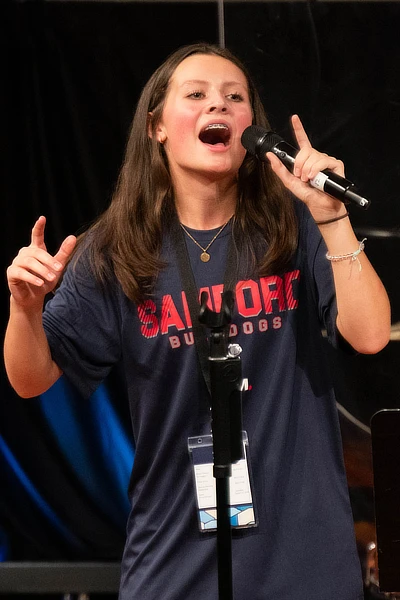
Animate, the flagship program of the Center for Worship and the Arts, is the place where we most fully embody our mission to engage intergenerational and artistic worship practices. It’s essentially a worship and arts camp for teenagers. In summer 2023, we set out on a qualitative research study with Animate participants to better assess their:
- liturgical curiosity
- formation, and
- experience of difference through the worship of Animate.
This blog constitutes the first in our series, What We’re Learning About Young People and Worship. Before we get to the research, though, a little more about our work.
At Animate, we are guided by a model through which we hope teenagers will be empowered to thrive as worshipers and as worship leaders in their congregational contexts. One central practice of this approach is the inclusion of ecumenically-informed liturgical diversity in our daily worship.
In other words, at Animate, worshipers participate in worship in a variety of styles, expressions, and idioms of worship led by diverse worship leaders, musicians, and preachers: high church, low church, scripted liturgy, extemporaneous prayer, celebration and confession, traditional hymnody with organ, contemporary worship with band, gospel choirs, Holy Communion, dramatic scripture readings by Samford theater faculty, and visual arts displays.
This diversity is intentional on our part since it comprises an important pedagogical method, to encourage young people to exit their worship homelands and move into foreign territory. Here are a few other key components of Animate:
- Community – students may come with their own churches or as individuals, but on Day One, we sort them into groups. These groups are intentional about having different ages and genders represented, different art forms represented, different races and ethnicities represented, and different denominational traditions represented.
- Selah prayer stations – multiple styles of interactive prayer activities, three different activities per day (examples from this year: writing your own lament, walking a large prayer labyrinth, painting with ashes). Many of these activities are unfamiliar to the students.
- Small Groups – students and adults meet twice per day in their groups to discuss and process what they are experiencing and learning at Animate.
- Toolbox Sessions – practical training classes and workshops in various art areas – examples, music theory, liturgical dance, filmmaking, kintsugi (mending broken pottery), guitar, piano, vocal techniques, etc.
- Studios – Q&A, panel-style discussions with practicing, professional artists.
- Showcases – performing artists (like a concert), field trip to the art gallery.
- The Village – late night outdoor fun with a large tent set up on university green space. Musical instruments galore, as well as art materials, board games, and sports equipment. This is where a lot of fun and creativity converges.
- Festival of Worship – everything builds up to the Festival of Worship, which is where the students, with the small groups they have been working with throughout the weeks, design and lead their own 10–15-minute worship service. On the day of the Festival of Worship, they get to choose a literal toolbox. Inside each toolbox is different, but they are given scriptures, a song book, prayer resources, and other tangible items that they can incorporate into their service. They spend the morning and afternoon planning, designing, and rehearsing their services. In the evening, they lead us in their services, then they are provided with real-time feedback by our “expert” clinicians who have served with us throughout the week (preachers and musical worship leaders).
Having encountered a variety of liturgical difference and having been equipped with new or strengthened skills in the arts, the end goal of Animate is for these teenagers and adult mentors to become agents of worship renewal, enhancing the liturgical life of their local congregation through their artistic gifts and leadership.
To visualize the Animate experience described above, check out this short recap video from 2023, and make plans to join us for Animate 2024! Register your interest here, and we will notify you when registration opens.
Next up in this series, we will share more about our research methods and context.
Emily Snider Andrews, Ph.D., is Assistant Professor of Church Music and Worship Leadership and Executive Director of the Center for Worship and the Arts at Samford University.
Rev. Nelson Cowan, Ph.D., Director of the Center for Worship and the Arts at Samford University, is a liturgical theologian, worship leader, and ordained pastor in The United Methodist Church.
